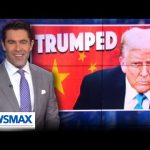The escalating trade tensions between the United States and China have reached a dramatic turning point, with President Trump imposing a staggering 125% tariff on Chinese imports. This bold move, part of his broader strategy to recalibrate America’s trade relationships, has drawn both praise and criticism. While Beijing responded with its retaliatory measures, raising tariffs on U.S. goods to 125%, Trump’s actions signal a decisive shift in America’s approach to global trade—a shift aimed at prioritizing American workers and industries.
For decades, China’s state-led economic practices, including currency manipulation and intellectual property theft, have disadvantaged American manufacturers and workers. Trump’s tariffs are a direct challenge to these practices, forcing Beijing to confront the consequences of its exploitation of global trade systems. Critics argue that such high tariffs risk disrupting supply chains and increasing costs for consumers, but supporters contend that the long-term benefits of leveling the playing field outweigh the short-term pain. Trump’s “America First” agenda underscores the necessity of confronting China’s economic aggression head-on.
The impact on the U.S. economy has been mixed but not without bright spots. The stock market saw a historic 3,000-point surge following Trump’s announcement of a 90-day pause on tariffs for most countries, coupled with the increased duties on China. This rally reflects investor optimism about the administration’s strategic focus on China while easing pressure on traditional allies. Major tech companies like Nvidia and Tesla led the charge, showcasing how targeted policies can foster confidence in American markets.
Trump’s approach also draws parallels to Ross Perot’s warnings about unfair trade practices during the 1990s. Perot famously predicted a “giant sucking sound” as jobs left America due to agreements like NAFTA. While ridiculed at the time, his concerns resonate today as millions of manufacturing jobs have been lost to globalization and China’s entry into the World Trade Organization. Trump’s tariffs aim to reverse this trend by incentivizing domestic production and reducing reliance on imports—a vision that aligns with Perot’s call for protecting American workers.
Despite criticism from some quarters, Trump remains steadfast in his belief that these measures are necessary to secure America’s economic future. His willingness to take bold action reflects a commitment to reshaping global trade dynamics in favor of American interests. As negotiations with China remain uncertain, one thing is clear: this administration is determined to hold adversaries accountable while ensuring that American workers are no longer at the mercy of unfair trade practices. The road ahead may be challenging, but Trump’s strategy offers hope for a more equitable and prosperous future for America.




